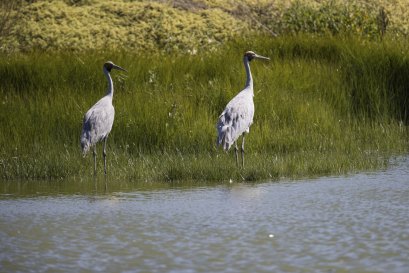
It’s the first confirmed sighting of an American golden plover in Victoria, generating huge interest and excitement among birdwatchers, also known as twitchers.
Birding Victoria tour guide Simon Starr, who has been birdwatching for 40 years, was taking a group of 15 people from the Illawarra on a tour of Werribee’s waterways when he first spotted the bird.

A pair of brolgas at the plant.Credit: Darrian Traynor
“The group stopped for lunch and very quickly I saw this incredible little bird,” he said. “I had my suspicions, took a lot of photos, did a bit of Googling and posted it online. And there was quite a lot of excitement, as you can imagine.”
That excitement has built as word of the diminutive rarity spread. Starr said twitchers from interstate have been booking flights to see the plover.
But it’s far from the only avian drawcard at Werribee. Some 295 bird species have been spotted at the Western Treatment Plant, including brolgas, freckled ducks and orange-bellied parrots.
Melbourne Water, which runs the plant, says it’s a wetland of international importance under the Ramsar Convention.
Loading
Every September, McCormack begins to drop the water levels at certain lagoons to create mudflats for migratory shorebirds, including the one in which the American golden plover has settled for a rest.
“It’s a pretty amazing spot, with the diversity of birds, the abundance of birds, and then the close proximity to major population centres as well – it’s a really unique location in that regard,” he said.
“And it’s pretty cool to see that the actions that we’re doing on site are actually benefiting species there.”
As for the gold-flecked lothario who lost his way, McCormack and his team remain hopeful the plover can find his way back to his flock.
“It’s hard to know whether it will get back to its breeding grounds given it’s so far off route ... but even though it’s in a different area, it [still migrated] from north to south and would then be going from south back to north … so hopefully, it innately knows to go back up north and then manages to find its way from Siberia into Alaska.”
Get the day’s breaking news, entertainment ideas and a long read to enjoy. Sign up to receive our Evening Edition newsletter here.









 Add Category
Add Category